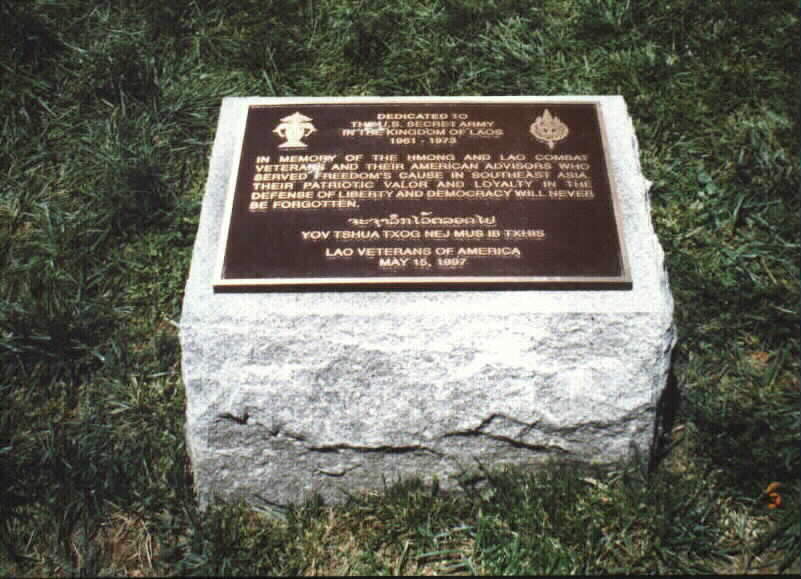The story of this Memorial is a story of sacrifice and patriotic valor by American Advisors and Hmong and Lao combat soldiers in the jungles of Southeast Asia during the Vietnam War.
Hmong General Vang Pao’s army, once considered among the best of U.S. allies, helped the Administrations of U.S. Presidents Kennedy, Johnson and Nixon in the “secret” Lao Theater. The United States in its effort to combat communist insurgency in Laos, recruited, armed, and trained ethnic minorities. Advised by the U.S. Central Intelligence Agency (CIA), General Vang Pao’s army of Hmong, Kmhmu, and Lao, gathered military intelligence, rescued downed U.S. air crews, protected U.S. Air Force navigational sites in Laos, and fought North Vietnamese General Vo Nguyen Giap’s ever increasing forces to a standstill in Laos for a decade.
When, after the fall of Laos, the communists took control, they launched a genocidal campaign to punish or eliminate those who allied with the United States, particularly those who had served in the U.S. Secret Army. Tens of thousands of Hmong escaped across the Mekong River to Thailand and refugee camps. From there, former soldiers and their families eventually were resettled in the United States. Once here, the Hmong adjustment proved difficult, but few Americans knew of their historical alliance with the U.S. adding to their resettlement problems.
Because the campaigns waged by General Vang Pao and General Giap were secret, most Americans knew little, if anything, of the secret war in Laos. Not until almost 20 years after falling to the communists did U.S. Government officials publicly admit the existence and role of the “U.S. Secret Army” in the “secret” Lao Theater of Operation of the Vietnam War. Appearing before Congress, in 1994, the Honorable William E. Colby, former Director of the Central Intelligence Agency, talked of the “heroism and effectiveness of the Hmong struggle” and the critical role and sacrifice of the Secret Army.
In part, Colby said:
“For 10 years, Vang Pao’s soldiers held the growing North Vietnamese forces to approximately the same battlelines they held in 1962. And significantly for Americans, the 70,000 North Vietnamese engaged in Laos were not available to add to the forces fighting Americans and South Vietnamese in South Vietnam.”
After Ambassador Colby’s acknowledgment, a handful of Americans who knew well the Hmong alliance with the U.S. felt it timely to seek official U.S. recognition for the soldiers of the Secret Army and their American Advisors who died in Laos. Mr.Grant McClure, a former U.S. Army Advisor to the Montagnards, became the moving force behind the idea of a permanent Memorial at Arlington to nationally and publicly honor the uncommon sacrifices of the Secret Army. Mr. McClure’s efforts brought together in common cause former CIA Station Chiefs, Vietnam Veterans, Members of Congress, and others who served in civilian and military roles, as well as Lieutenant Colonel Wangyee Vang, founder of Lao Veterans of America, Inc.
Finally, after discussions with officials of the U.S. Government and the Lao Veterans of America, whose members number some 55,000 former soldiers and their families of the Secret Army, agreement on a Living Memorial at Arlington National Cemetery was reached.
On May 15, 1997, some 3,000 veterans of General Vang Pao’s army – Hmong and Lao – dressed in jungle camouflage fatigues, flight suits, nurses uniforms stood at attention on the Mall in Washington, D.C. near the Vietnam Wall. Facing them were current Members of Congress, former U.S. Ambassadors, and the CIA Station Chiefs under whom they had served during the time of the “secret war” in Laos. A Congressional citation was read. CIA Station Chiefs paid tribute to the extraordinary contributions of General Vang Pao and his brave forces in the fight for freedom in Southeast Asia and assisted in handing out the Vietnam Veterans National Medal.
The next day, General Vang Pao and the remnants of his army, again wearing camouflage fatigues, assembled at Arlington National Cemetery. Six deep, they stood at attention for the dedication of the Memorial Monument – a small stone topped with a copper plaque, acknowledging the “secret war” in Laos – and the Hmong, Lao, and American Advisors who valiantly served freedom’s cause in the jungles of Southeast Asia and, in so doing, died in the Lao Theater in the Vietnam War. They will now be forever known and remembered.
Contributed in Loving Respect, September 1999 by Dr. Jane Hamilton-Merritt,
Nobel Peace Prize Nominee, Author of Tragic Mountains: The Hmong,
The Americans, and the Secret Wars for Laos 1942 – 1992.
In Memory of Legions Lost and the
Soldiers of the Secret War in Laos.
_______________________________________________________
We stand in tribute of forgotten men…for their sacrifice, courage
valor and honor. We honor them by this living memorial…starkly
beautiful in its simplicity, for it stands defiantly alone, as did those
soldiers in their seasons of death. It will serve as a poignant reminder
of our battlefield allies, and is a tribute long overdue to proud Human
endeavor…courage and valor in a long war lost in the unfulfilled hopes
for Southeast Asia.
As the fallen leaves of Autumn
in unregimented ranks,
Countless unrembered soldiers
rest…eternally.
Let us now praise forgotten men…
and some there be,
Which have no memorial;
Who have perished, as though
They had never been.
But they served, they died;
for cause and by happenstance…
Expended in the hopes for Southeast Asia,
and will forever be remembered,
Mourned for their sacrifice.
If by weeping I could change
the course of events,
My tears would pour down ceaselessly
for a thousand Autumns.
Thursday, May 15, 1997
Salute to Lao/Hmong Patriots
& their American Advisors
Arlington National Cemetery
Michael Robert Patterson was born in Arlington and is the son of a former officer of the US Army. So it was no wonder that sooner or later his interests drew him to American history and especially to American military history. Many of his articles can be found on renowned portals like the New York Times, Washingtonpost or Wikipedia.
Reviewed by: Michael Howard

